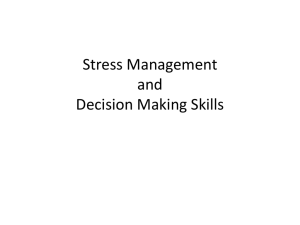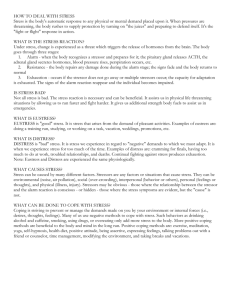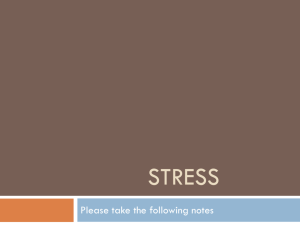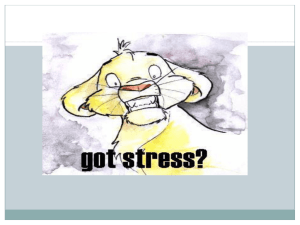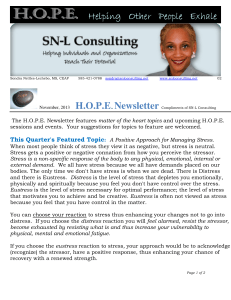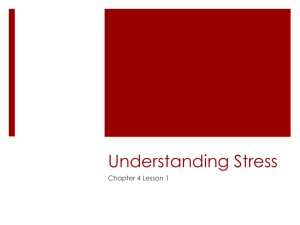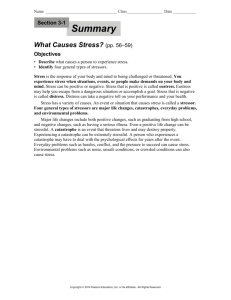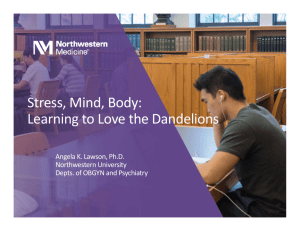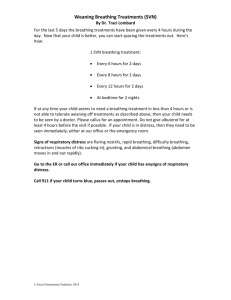PPT
advertisement
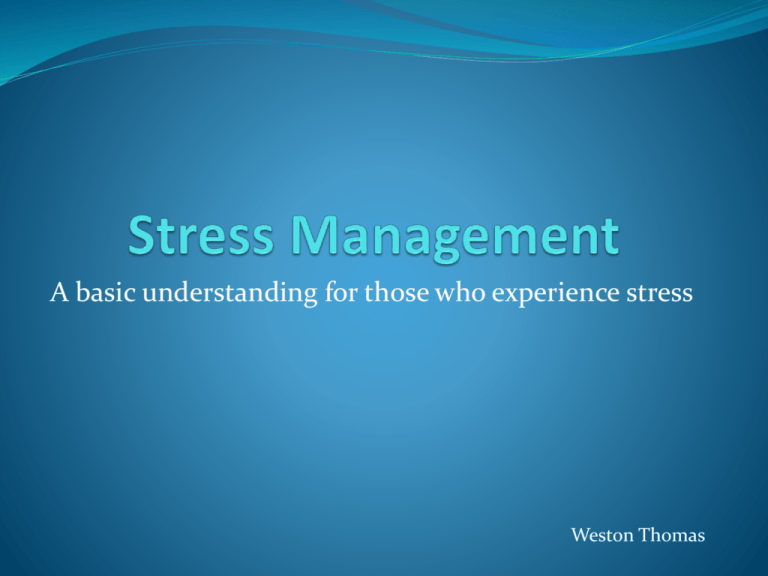
A basic understanding for those who experience stress Weston Thomas What is stress? While stress may be different from person to person, stress is the bodies reaction to a stressor. There are two types of stress, eustress and distress. Distress Distress is negative stress. It can have adverse affects mentally and physically. Distress can be short or long term, cause anxiety, and be unpleasant. Some reactions to distress may include: 1. 2. 3. 4. 5. Sweating Irritability Memory loss Depression Aches and pains Eustress Eustress is considered to be good stress, and is healthy to experience. This type of stress can be motivating and beneficial throughout life. Some examples of situations that may cause eustress: 1. 2. 3. 4. 5. Athletic competition Marriage Having children Exercise Job promotion Acute Stress Acute stress is experienced in small doses. This type of stress can be positive or negative. 1. A positive example could be riding a rollercoaster. 2. A negative example could be an a car accident. Chronic stress Chronic stress is stress that occurs over an extended period of time. When not addressed, long term stress can lead to substance abuse, depression, and anxiety. An example of chronic stress is relationship problems. What is a stressor? A stressor is a trigger that causes the stress reaction. Everyone may have different stressors. Examples of stressors: 1. Alcohol and tobacco 2. Time restraints 3. Heavy workload 4. Finances 5. Relationships Fight or flight One response to a stressor is fight or flight. Fight or flight is a primitive response to a stressful or threating situation. When this response occurs an individual either faces the situation or flees. Physiological reactions Increased heart rate Elevated blood pressure Increased blood flow Heightened senses Adrenal cortex releases adrenaline Metabolism increases Muscle tension Increased breathing Stress and your health Stress can have a negative affect on your physical and mental health. Stress can cause anxiety and depression. Your heart is directly affected by stress. When experiencing stress your heart rate and blood pressure may increase, and hormones released can increase cholesterol. Coping with stress There are many techniques for dealing with stress in a positive manner. There are both physical and mental ways to cope with stress. Meditation There are many different forms of meditation practiced across the world. Meditation can involve analyzing your mental and emotional state. You can help separate yourself from the outside world and focus on your mind. Meditation is calming and promotes relaxation. Sleep Sleep directly affects stress. When you are tired you are more easily irritated and angered which can lead to more stress responses. It is recommended that you receive around 8 hours of sleep a night. Exercise Exercise and help reduce and prevent stress! During exercise, endorphins are released when which help you feel good. Exercise can also help improve your mood, raise your self confidence, and improve your sleep. Group exercise can be motivating! Convenient exercises Many exercises can be performed anywhere with no equipment! 1. 2. 3. 4. 5. Pushups Sit ups Jumping jacks Burpees Squats How Convenient! Diet Your diet has a direct correlation with stress! Staying hydrated can help keep your brain functioning properly. Stimulants can stimulate stress responses when no stressor is present and raise blood pressure. Salt can also increase your blood pressure. Be sure to consume daily recommended intake for vitamins and minerals. Which foods help reduce stress? Socialize Spending time with your friends and family can be enjoyable and help reduce your stress. Talking about what is stressing you out with your friends can help calm you. Spending time with friends and family can improve your mood. Breathing Deep breathing exercises are directly related to relaxation. Breathing can help lower your blood pressure and heart rate. These exercises are very simple. Deep breathing can be performed anywhere. Breathing Techniques Breath counting- Take deep breaths and on each exhale count your breath. Once you reach five breaths go back to one and continue up to five. Coherent breathing- Coherent breathing consists of taking five breaths per minute. Count to about five on both your inhale and exhale to achieve this. Both techniques should be done for about a ten minute duration. References http://cas.umkc.edu/casww/brethexr.htm http://www.helpguide.org/mental/stress_signs.htm http://www.stress.org/
